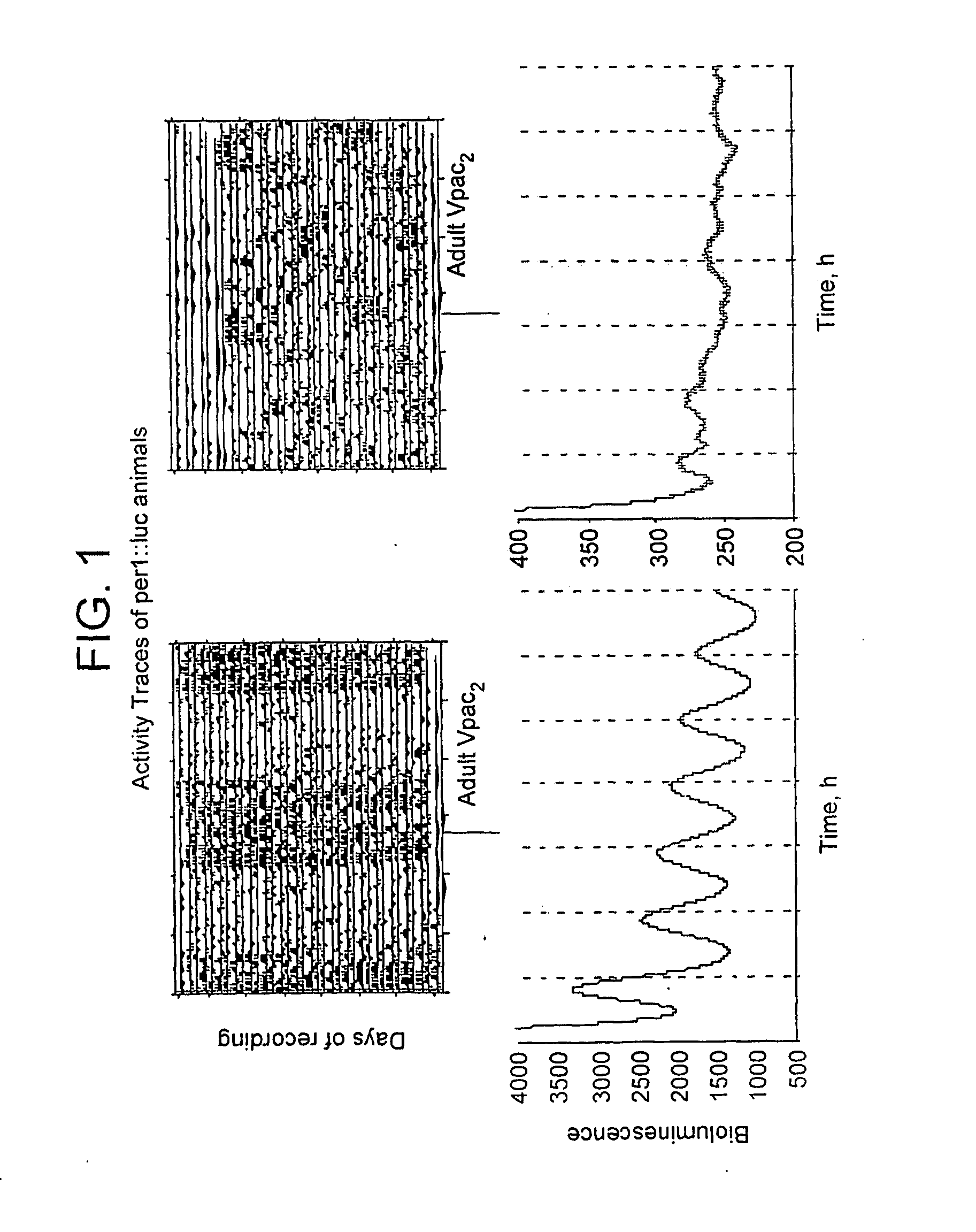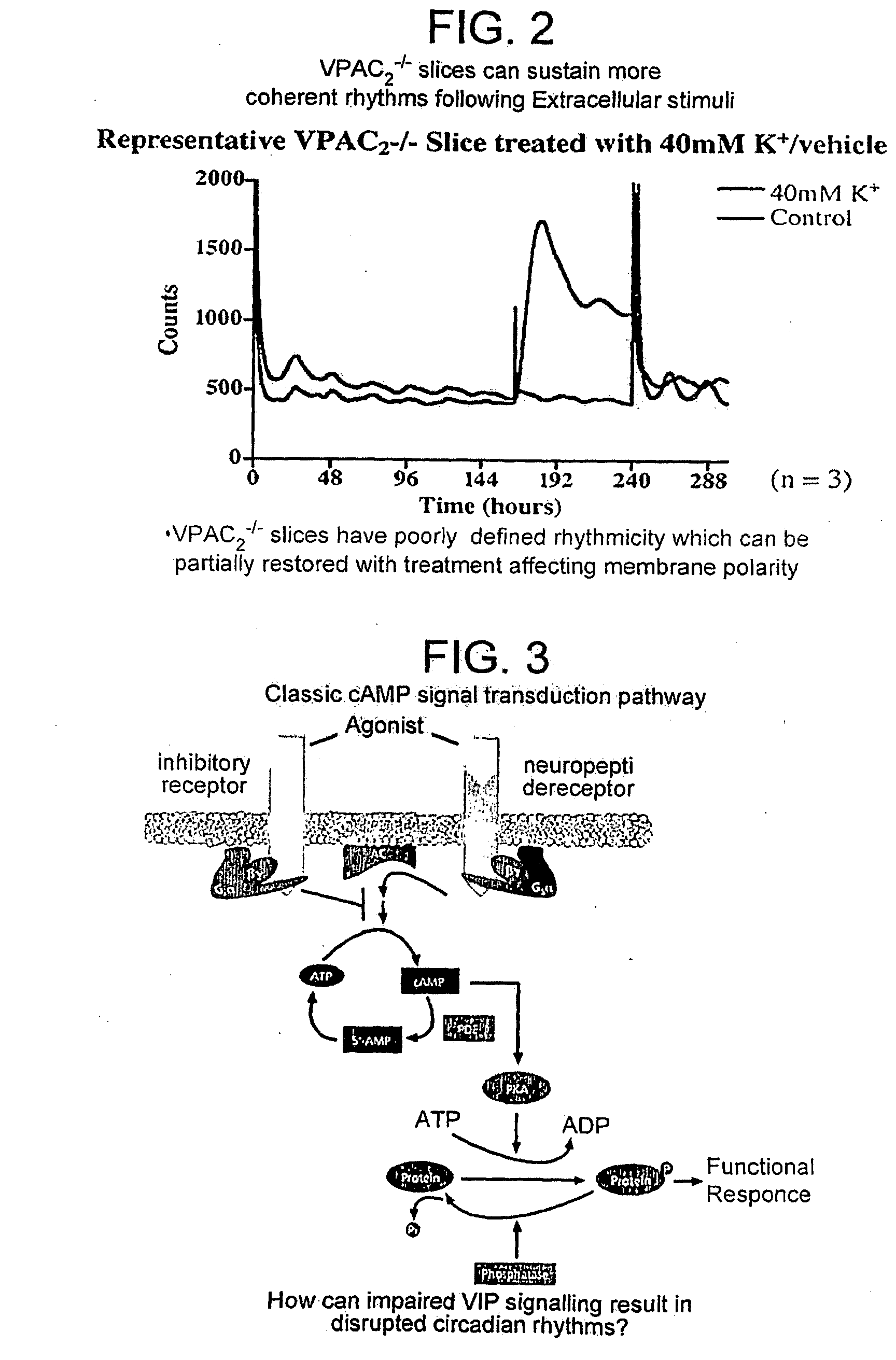Inhibitor of Adenylyl Cyclase for Treating a Disorder of the Circadian Rhythm
a technology of adenylyl cyclase and adenylyl cyclase, which is applied in the field of manipulation of the circadian clock, can solve the problem that the study of the various outputs or effectors does not permit manipulation or adjustment of the fundamental underlying clock mechanism, and achieve the effect of reducing brain damag
- Summary
- Abstract
- Description
- Claims
- Application Information
AI Technical Summary
Benefits of technology
Problems solved by technology
Method used
Image
Examples
example 1
Cyclic AMP-Dependent Signals Sustain Molecular Time-Keeping in Mammals and Determine Circadian Period
Introduction
[0233]Circadian timing in mammalian cells is based upon an auto-regulatory transcriptional / post-translational feedback loop, pivoted around the rhythmic expression of Period and Cryptochrome genes. Although circadian activation of various second-messenger signalling cascades (including cyclic nucleotides, MAPK and calcium) has been widely observed, their role within the clockwork has been viewed primarily in respect of entrainment, most obviously induction of Per expression. In VIP2 receptor knockout mice (Vip2r− / −), however, the molecular clockwork is suspended in most suprachiasmatic nucleus (SCN) neurons. This receptor signals via adenylyl cyclase (AC). We therefore sought to test the role of AC signalling in maintaining circadian time-keeping in mammals, using real-time bioluminescent recording of circadian gene expression.
Experimental
[0234]Inhibition of the Gsα-bindi...
example 2
Demonstration of Prolongation of Circadian Rhythm Using Adenylyl Cyclase Inhibitors
[0236]We disclose the cyclic AMP (cAMP) pathway as a new mode of manipulating circadian rhythms in mammals. We show that observed twice-daily, intracellular changes in cAMP levels are an essential feature of the clock, rather than an output. Our manipulation of cAMP synthesis confirms this role. Furthermore, the invention identifies previously characterised intracellular targets for this application.
[0237]Firstly, we, have found that treatment of a range of mouse tissues (e.g. organotypic brain and kidney slices, fibroblasts etc) with common, commercially available-inhibitors of the enzyme adenylyl cyclase-prolongs circadian period (as detected by a range of bioluminescent reporters) from ˜24 to >30 hours, without dampening them. This effect is unprecedented in circadian physiology / pharmacology.
[0238]The preferred inhibitors according to the present invention belong to a class historically called P(pu...
example 3
[0242]FIG. 1 shows activity traces of per1::luc animals with different genetic states with respect to VPAC2. Animals negative for the receptor are behaviorally disorganised.
[0243]FIG. 2 shows VPAC2− / −-slices can sustain more coherent rhythms following extracellular stimuli.
[0244]FIG. 3 shows a diagram of a classical cAMP signal transduction pathway.
[0245]VPAC mice are poorly rhythmic in their behaviour. This is reflected in the poor rhythmicity and low amplitude SCN rhythms. Electrophysiological measurements have shown that an additional phenotype of VPAC SCN is that they are hyperpolarised. Thus, they can be “kick-started” by K+, or AP-4 (sodium channel blocker). This temporally restores synchrony and some amplitude to the slice.
[0246]This effect is likely mediated, at least partly by an extra-cellular calcium flux, as it can be abrogated by pretreatment of the slice with 1.6 uM EGTA.
[0247]However, VPAC receptor is not an ion channel, but is actually a GPCR which is...
PUM
| Property | Measurement | Unit |
|---|---|---|
| temperature | aaaaa | aaaaa |
| dissociation constant | aaaaa | aaaaa |
| time | aaaaa | aaaaa |
Abstract
Description
Claims
Application Information
 Login to View More
Login to View More - R&D
- Intellectual Property
- Life Sciences
- Materials
- Tech Scout
- Unparalleled Data Quality
- Higher Quality Content
- 60% Fewer Hallucinations
Browse by: Latest US Patents, China's latest patents, Technical Efficacy Thesaurus, Application Domain, Technology Topic, Popular Technical Reports.
© 2025 PatSnap. All rights reserved.Legal|Privacy policy|Modern Slavery Act Transparency Statement|Sitemap|About US| Contact US: help@patsnap.com



